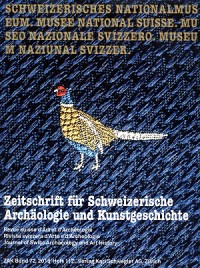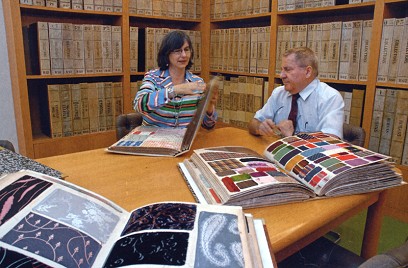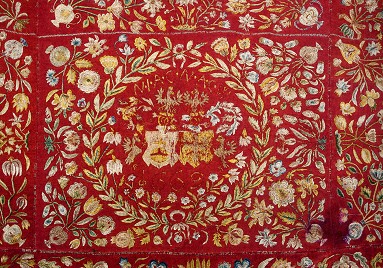

Sigrid Pallmert with Sampler books, bequest of Abraham AG, Zurich, and
Walter Zimmermann former staff member of Abraham AG.
Swiss National Museum, Foto Donat Stupan, 2007
| ANNE WANNER'S Textiles in History / books |
| In
Remembrance to Sigird Pallmert, curator at the National
Museum of Switzerland, Zurich texts compiled in the magazine ZAK (Zeitschrift für Schweizerische Archäologie und Kunstgeschichte) Bd. 72 2015 Heft 1 / 2 ISSN 0044-3476 |
| The texts of
this special issue of ZAK-magazine were put together in
remembrance to Sigrid Pallmert, curator of the textile
department and art historian at the Swiss national
Museum. She passed away unexpectedly on the 9th of August
2012. Severeral collegues they too researching in the
field of textiles were ready to contribute and as a
result this present issue with subjects from the middle
ages up to the present days came into being. Sigrid Pallmert curated the textile department for 28 years. Some of her special exhibitions like "Modedesign Switzerland 1972-1997", "Bling Bling - fabrics from St.Gallen", "Soie Pirate - Textile archives from Abraham Zurich" arouse wide public interest. |
|
 Sigrid Pallmert with Sampler books, bequest of Abraham AG, Zurich, and Walter Zimmermann former staff member of Abraham AG. Swiss National Museum, Foto Donat Stupan, 2007 |
| A
contribution from the italian speaking part of
Switzerland, the Tessin, was written in italian language
by Patricia Lurati. "Avere la stoffa del santo" Affreschi e tessuti nel Canton Ticino tra XIV e XV secolo ....... ...............................p.3. Here the author compares textiles depicted on frescoes from the Ticino from middle of 15th to the end of 15thc. The fresco painter not only wanted to render the real textile, but the splendid fabrics also emphasize the social status of the person. This status makes it possible to wear precious textiles and moreso could he affort to override rigourous rules of conduct. |
|
Caroline
Vogt. Erinnerungsperlen. Ueberlegungen zur Mitra
des Klosters Kreuzlingen als Medium des kulturellen
Gedächtnisses
......................................................................p.
21 Caroline Vogt compares existing documents with the real mitre of the Kreuzlingen Augustinian monastery which until recently was regarded as a papal gift to its abbot Erhard Dominik Lind by Pope John XXIII in occasion of the Council of Constance. The oldest parts of this mitre probably only date after the Concil. It was reworked several times. But there are 2 documents bearing witness to the papal privileges conceded to the abbey in 1414 and included was the right to wear a mitre. This bestowal of the mitre to Erhared Dominik Lind is mentionned in words and image in the Chronicle of the Council. The link between the report in the Chronicle and the actual mitre gave rise to the actual legend of the papal gift. This commemorates its monastic provenance, a memory still persisting in the appropriation of the monastic coats of arms by the city of Kreuzlingen. Mitre, convent of Kreuzlingen, reverse with Saint Margaret and Evangelist Marcus, Frauenfeld, Historisches Museum Thurgau, Inv.Nr. T 83 |
| Anna
Rapp. Gewirkte Paramente aus den Klöstern
Rathausen und Eschenbach
.........................................................................
p.37 Here th author deals with an alter hanging in tapestry weave, acquired by the National museum in 2012. The middle part of this hanging was the last acquirement initiated by Sigrid Pallmert, the side panels belonging to the National Museum already several years. The coat of arms indicate that it was a gift of the Abbess Verena Frey to the Rathausen convent church. Very soon it became obvious that this recently discovered piece belongs to a group of distrinctive fabrics created in the first half of the 17th c. especially for the Rathausen convent. Probably the workshop of its origin was located in Eschenbach. Earliest known works of the group may be dated in the late 16th.c. It seems that the abbesses of Rathausen and Eschenbach convents with gifts of paraments of that workshop were supporting the spiritual life and adoration of the saints in their respetive nunneries. |
|
| Margret
Ribbert. Eine Walliser Tischdecke aus dem Jahre
1669 im Historischen Museum Basel
...................................p.53 The Historical Museum Basel owns since 1894 an embroidered floral tablecloth with the coat of arms of de Courten and de Werra families from Valais. The embroidered date of 1669 and initials make it clear that the tablecloth belonged to Jean Antoine de Courten and Anne Catherine de Werra. It is fashioned out of 44 large and very small pieces of 4 different red woolen fabrics and embroidered in multicolored silk yarns. It may have been worked collectively in a domestic context rather than in a professional workshop. The large crowned monogram of Anne Catherine underlines her importance in the working of the piece. |
|
 Table carpet with coat of arms of de Courten and de Werra, dated 1669. 192 x 236 cm. Historic Museum Basel, Inv. 1894.408 |
| Verena
Villiger Steinauer. Ein Musterbuch für
Strumpfstricker (um 1630-1650)
..............................................................p.71 The technique of knitting in earlier times was especially suitable for stockings. They were knitted in wool, cotton or silk. The Museum of Art and History in Freiburg owns a book of samplers for knitters which probably dates from between 1630 to 1650. Besides the instructions for knitting stockings there are also descriptions for gloves, jerkins and caps, as well as recipes for dying textiles and for a few healing remedies. This manuscript may well be related to a project to prevent unemployment. |
|
Andrea
Franzen. Männersache. Gilets brodés des 18.
Jahrhunderts aus dem Historischen Museum Bern
.................................................................................
p.79 The subject of this article are the embroidered waistcoats and gilets of the Historical Museum Bern and they demonstrate skills and artistry of embroiderers in the 18th c. Professionals pre-embroidered the waistcoat panels and they were produced in great quantities near Lyon and also outside France. The motives are typical for the periods ideals of nature and rural life, the outgoing 18th c. being marked by a preference of antiquity. Each piece is unique even if one may find an early form of industrial production in the making of the waistcoats. Men's waistcoat, around 1780-1800, embroidered with satinstitch, spangles and couching, Historic Museum of Berne, Inv.Nr. 60746 |
| Anna
Jolly. Niederländische Leinendamaste aus
Schloss Wildegg
...........................................................................p.93 The Castle of Wildegg formerly kept linen damasks of the Effinger family. Since 1983 they have been on permanent loan to the Swiss National Museum. The here discussed examples give an idea of the production methods of Flemish linen damask manufactories in the late 17th and 18th c. The author compares these damasks with similar or related pieces of other collections. It is shown that the manufactories in Courtrai in the Netherlands regularly revived successful or popular compositions and adapted them to the current events. By adding or changing inscriptions on the damasks these events were identified. |
|
Nikkibarla
Calonder, Ulrike Rothenhäusler und Mylène Ruoss.
Frühe Hauskrippen aus der Sammlung des Schweizerischen
Nationalmuseums ............................. p.109 The writer Cécile Lauber from Lucerne was collecting figures for nativity scenes. These figures were given after her death to the Swiss National Museum and there they were combined with other examples of nativity scenes of the museum collection. In the late 18th and early 19th c. many kinds of similar figures existed, as for instance a paper cut out from Augsburg, a fine bone china sculpture from the Schooren Manufactory in Kilchberg near Zurich, 2 sets of figures wearing textile dresses. The original figures of Cécle Lauber were inventarised, the textiles and the wax parts conserved by the laboratories of the National Museum. Black king, velvet garment with goldtresses. Mantle with chiné fabric around 1820. Formerly at castle of Altenklingen, Switzerland. |
| Jürg
Burlet. Uniformen und Fahnen im Schweizerischen
Nationalmuseum - Eine kleine Zeitreise zu den Anfängen.
p......129 Since the opening of the Swiss National Museum flags and uniforms always played an important role. Besides their history the problem of conserving textiles has been a challenging task. In his article Burlet traces the work of restorers at the Swiss National Museum over the past 100 years. During this time the approach to restoration has changed substantially. |
| Tina
Moor. Silk Memory - Ein Atelierbericht
.................................................................................................................................
p.143 The article reports on 2 workshops, one at the University of Design and Art in Lucerne and the other one at the National Institute of Design at Ahmedabad in India. Both workshops were taking place in the context of the research project Silk Memory at the Lucerne University of Art and Design. One of the goals of the Silk Memory project is to set up a database and make it accessible to faculty, researchers, students and designers as a source of inspiration. Another goal is to preserve and study the development of textile techniques. In the workshop the students used as inspiration both the database as well as their local and native patterns. Very interesting contemporary interpretations resulted from these studies. |
| home content | Last revised 27 July 2015 |